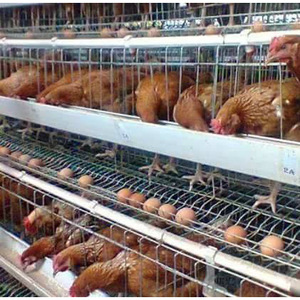Feeding management of caged laying hens
- font size
- Be the first to comment!
The layer chicken cages effectively improved the utilization rate of the land and the pens, but the chicken houses were tightly closed, the ventilation was not good, and the harmful gases in the circle were easily exceeded. At the same time, the caged chickens were fixed in narrow cages and isolated from the soil. , easy to start all kinds of diseases. It affects the breeding benefits, so the management of cage laying hens is particularly important.
1. Choose a variety
There are many excellent laying hens inside and outside, such as the self-supporting chicken, Luodao red chicken, Xianju chicken, Xiaoshan chicken, etc. On the basis of excellent laying hens, the products are bred by advanced breeding methods. It is also a species commonly selected by farmers today, such as Roman brown hens, Hailan brown shell hens, etc. When selecting laying hens, it is necessary to choose a disease resistance, adaptability, and production according to local natural and climatic conditions. Eggs with more eggs and less material consumption. When introducing seeds, it is necessary to strictly abide by the relevant quarantine requirements stipulated by national regulations and to complete quarantine procedures.
2. Use good feed
It is recommended that farmers use full-price compound feed in the process of laying hens: full-price compound feed can meet the nutritional needs of chicks, broiler chickens and laying hens without using other substances in the process of use: Many, the price difference is large, the quality is uneven, the farmers must make more choices when purchasing, shop around, to be of high quality, not to be cheap, otherwise it will not be worth the candle.

3. Scientific management
Chicks from 0 to 6 weeks old are called chicks. The chicks have poor body temperature regulation, rapid growth and development, weak digestion, poor disease resistance, strong sensitivity and timidity. Therefore, the focus of chick feeding is to increase the survival rate.
Before the brooding, we will thoroughly disinfect the chicken house, chicken cage, etc. with the net poisoning, or flame disinfection: after disinfecting the drinking fountain and the trough with Corvwei and bacteria poisoning disinfectant, clean and spare. Within 1 to 2 days before brooding, the temperature inside the house was raised to about 35 °C, and the relative humidity was maintained at about 70%.
4. Temperature, humidity and lighting
Chicks are sensitive to temperature, humidity and light, especially the first 2 W of brooding. On the first day of brooding, the temperature of the pens should be 32-34 ° C, then reduce by 0.5-0.7 cc per day, about 3 ° C per week, until the end of 42 d brooding to 20 ° C: high humidity will Affects water metabolism and is prone to pathogen reproduction; when humidity is too low, it affects yolk absorption and is prone to cause respiratory diseases. The control principle of relative humidity is: high in the early stage and low in the late stage, that is, the humidity before the 10th day is 60% to 70%, and 55% to 60% after the 10th age: the intensity and time of the light affect the feed intake and sexual maturity of the chick. The process, so use the 60.100 w bulb 3 d before brooding, each eye N23 h left; after 3 d, change to 45 ~ 25 W bulb. The illumination time is decremented by 1~2 h per week: natural light plus nighttime fill mode can also be used.
The caged laying hens have high density of feeding and high egg production performance. The raising and management of caged laying hens can effectively improve the breeding efficiency. In the management of chicks, it is better to “make a living” and to control the breeding of chickens. In the management of laying hens, the “nutrition” can be achieved to maximize the breeding benefits.


